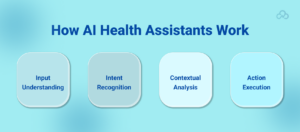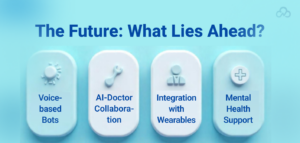Imagine a life where you can book an appointment, describe your symptoms, and receive initial diagnostic technology all through a conversation just with a smart bot. No standing queues. No waiting rooms. Just quick, intelligent assistance always available 24/7.
Welcome to the new world of AI in healthcare, where smart bots are no science fiction. But they’re real,trustable, and fastly becoming a main part of how we interact with healthcare industries.
From reducing administrative tasks to enabling faster, more accurate diagnoses, AI health assistants are evolving the way doctors and patients communicate. Powered by advancements in diagnostic technology, AI is a game-changer not only for medical professionals but also for everyday patients suffering from complex healthcare systems.
In this blog, we’ll explore how AI-driven bots are transforming doctor-patient relationships in the role of AI services for customer experience, and why MVP development services are enhancing innovation in diagnostic technology.
The Rise of Smart Bots in Diagnostic Technology
Let’s understand it- modern healthcare is under a lot of pressure. Like, overworked professionals, limited infrastructure, and increasing patient demands make it difficult to deliver customized care much.
Using smart bot- AI-powered virtual assistants are designed to work on human-like conversations, answer queries, collect medical data, and assist in triaging patient symptoms. Unlike old systems, bots can work 24/7 without fatigue or delays, making them fit for high-demand environments.
For example, during the COVID-19 pandemic, chatbots helped millions of patients with self-assessment tools like- symptom tracking, and mental health support all without the help of a single doctor’s visit.
What has been started as a necessity now evolved into a proper channel for non-emergency medical interaction.
How AI Health Assistants Work

AI health assistants are embedded by Natural Language Processing (NLP), machine learning models, and diagnostic technology. And here’s a simple version of how they work:
1. Input Understanding: The bot understands and analyzes user queries whether typed or spoken.
2. Intent Recognition: It understands the user’s intent (symptom checker, appointment booking, information request, etc.).
3. Contextual Analysis: They use trained datasets to interpret the user’s medical history, symptoms, or keywords to provide relevant responses.
4. Action Execution: It offers a suitable response such as advising rest, suggesting a consultation, or forwarding the information to a physician.
Some advanced bots even integrate with Electronic Health Records (EHRs) that allow them to fetch relevant patient data and customize responses accordingly.
Transforming Doctor-Patient Interaction
Here’s how smart bots are elevating the doctor-patient relationship:
1. 24/7 Availability
Olders clinics had operating hours but smart bots didn’t.
Now patients can interact with AI health assistants anytime at midnight, during a lunch break, or while traveling. This on-demand accessibility creates trust and satisfaction, especially for those with chronic conditions who need regular support.
2. Reduced Doctors Workload
Doctors were spending most of the time on repetitive tasks like- answering common questions, reviewing symptom reports, and scheduling appointments. So, now bots allow doctors to focus on what they do best treating patients by handling these functions.
3. Improved Diagnostic Technology
AI bots can detect early signs of illness using predictive analytics and diagnostic technology with access to large datasets. While it’s not a replacement for professional evaluation but still serves as an amazing first step in lowering down potential conditions.
4. Enhanced Patient Engagement
AI services for customer experience are not limited to retail anymore. In healthcare, they use bots to speak in a patient’s language, show empathy, and offer timely reminders for medication or follow-ups which keep patients engaged and healthier.
Diagnostic Technology: The Brain Behind the Bot
The core of every good AI health assistant is advanced diagnostic technology. This refers to a set of tools and algorithms that can analyze medical symptoms, history, and behavioral data to help with decision-making.
Some live examples include:
1. Babylon Health: A UK-based app that gives health consultations based on user input and medical history using AI.
2. Buoy Health: An AI tool that helps people to navigate symptoms and access to appropriate care.
3. Infermedica: A platform that is used by hospitals and telemedicine providers for symptom checking and triage support.
These systems use structured and unstructured data to provide highly accurate diagnostic insights, which match or even surpass human-level performance in specific use cases.
Role of MVP Development Service in Building Health Bots
Building an AI healthcare solution from ground zero can be stressful especially when regulations, privacy concerns, and infrastructure challenges are there. This is where MVP (Minimum Viable Product) development services come in.
Here’s why an MVP can be the best approach:
– Faster Time to Market: Developers can build a working version in just a few weeks and try it out in real situations.
– Patient Feedback Integration: By collecting feedback before, the product can be improved amazingly for better results.
– Cost Efficiency: Building a full-featured bot first can be expensive. But an MVP can help startups or clinics test the waters before going all in.
– Compliance-Ready: MVP services include features like data encryption, HIPAA compliance, and user authentication to meet healthcare standards.
Whether you’re a health tech startup or a large hospital chain using an MVP development service can give your smart bot a secure, and user-tested foundation.
AI Services for Customer Experience in Healthcare
In today’s high-tech world patients want the same level of personalization from their healthcare providers as they do get from their favorite e-commerce brands.
That’s where AI services for customer experience rise and shine. These include tools that optimize patient journeys such as automate feedback collection, and offer AI-driven recommendations all in real-time.
Some examples are:
– Customized Care Plans: This is based on user data where AI can suggest customized diet plans, medication schedules, and wellness tips.
– Chat-based Emotional Support: Smart bots trained in psychology give conversational mental health check-ins.
– Behavioral Insights: Predictive AI can spot at-risk patients based on changes in interaction of patterns and flag them for human checkups.
Benefits of Smart Bots in Healthcare
Accessibility
AI bots reduce location and time barriers, especially for rural or remote communities.
Consistency
Bots don’t get tired unlike humans. Their responses are standardized to reduce the risk of misinformation.
Scalability
It handles the load effortlessly whether 10 or 10,000 users interact with the bot and it’s a major advantage during a health crisis.
Multilingual Support
Many bots now support regional languages and dialects which fill the communication gaps in multicultural countries like India or the U.S.
Data Collection & Insights
Smart bots collect valuable data on patient behavior, preferences, and symptom trends that is crucial for future treatments or public health planning.
Challenges and Ethical Concerns
Of course, it won’t be easy. There are genuine challenges to address:
1. Data Privacy: Patient data is sensitive. Bots must comply with GDPR, HIPAA, and other privacy regulations to keep data safe.
2. Bias in Algorithms: If bots are trained on biased data they can make wrong suggestions , especially for minorities.
3. Over-Reliance: Patients may delay necessary care if they trust bots too much without human confirmation.
4. Transparency: Users should always be informed that they are interacting with a bot and not a human.
Developers, hospitals, and policymakers must work together to build trust, ensure transparency, and keep humans in the loop.
The Future: What Lies Ahead?

We’re just working on the surface level of what AI health assistants can do.
1. Voice-based Bots: Like Alexa, but trained for healthcare support and diagnostics.
2. AI-Doctor collaboration: Smart bots will help doctors during live consultations with data-backed suggestions.
3. Integration with Wearables: Bots will access to Fitbit or Apple Watch data to give real-time health reports.
4. Mental Health Support: As awareness rises, bots trained in CBT (Cognitive Behavioral Therapy) and mindfulness will become more common.
Real-Life Success Story
Apollo Hospitals, one of India’s leading healthcare providers, introduced an AI chatbot named Ask Apollo. It allows users to ask medical queries to find specialists, and book appointments easily. The platform got a 30% increase in engagement and significantly reduced call center loads which proved the effectiveness of smart bots in large healthcare ecosystems.
Conclusion
AI in healthcare is not a dream, it’s happening now. Smart bots are already changing the doctor-patient relationship by using diagnostic technology and those who use them early will lead the way in creating smarter, more humane, and efficient care systems.
Whether you’re a health startup looking to build the next big thing with MVP development services or a hospital trying to enhance customer experience through AI services, now is the great time to invest.
FAQs
Q1. Are AI health assistant are accurate?
Yes, especially when trained by quality data and regularly updated. However, they will not replace professional medical advice.
Q2. Can smart bots handle emergencies?
Most bots are designed for non-emergency care. During emergencies, they redirect users to professional help.
Q3. Is patient data safe with health bots?
Yes they are very secure as when built with security in mind and complying with regulations. Always choose trusted providers.
Q4. How much does it cost to build a healthcare bot?
Costs vary depending on features. Starting with an MVP helps manage costs and iterate based on real feedback for any startups.
Q5. Can AI bots understand regional languages?
Yes! Many bots now support multilingual NLP for better understanding.
Do you like to read more educational content? Read our blogs at Cloudastra Technologies or contact us for business enquiry at Cloudastra Contact Us